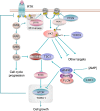Phosphatidylinositol 3-kinase (PI3K) pathway activation in bladder cancer
- PMID: 20013032
- PMCID: PMC2797439
- DOI: 10.1007/s10555-009-9198-3
Phosphatidylinositol 3-kinase (PI3K) pathway activation in bladder cancer
Abstract
The phosphatidylinositol 3-kinase (PI3K) pathway is a critical signal transduction pathway that regulates multiple cellular functions. Aberrant activation of this pathway has been identified in a wide range of cancers. Several pathway components including AKT, PI3K and mTOR represent potential therapeutic targets and many small molecule inhibitors are in development or early clinical trials. The complex regulation of the pathway, together with the multiple mechanisms by which it can be activated, make this a highly challenging pathway to target. For successful inhibition, detailed molecular information on individual tumours will be required and it is already clear that different tumour types show distinct combinations of alterations. Recent results have identified alterations in pathway components PIK3CA, PTEN, AKT1 and TSC1 in bladder cancer, some of which are significantly related to tumour phenotype and clinical behaviour. Co-existence of alterations to several PI3K pathway genes in some bladder tumours indicates that these proteins may have functions that are not related solely to the known canonical pathway.
Figures







References
Publication types
MeSH terms
Substances
Grants and funding
LinkOut - more resources
Full Text Sources
Other Literature Sources
Medical
Research Materials
Miscellaneous

